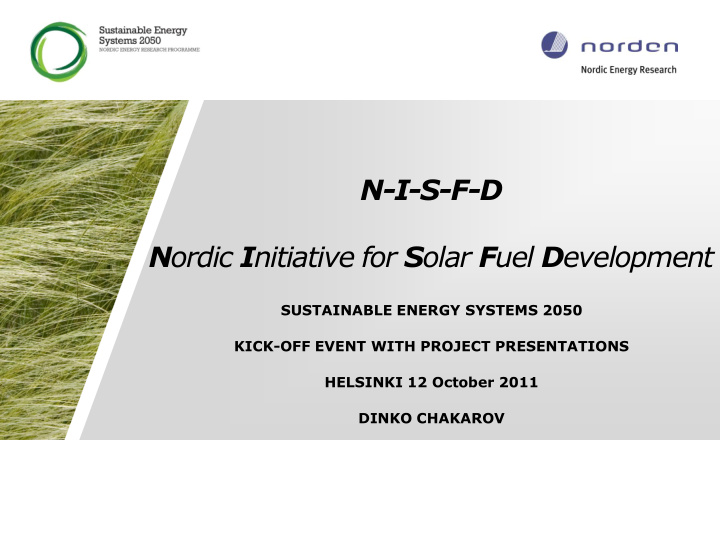



N-I-S-F-D N ordic I nitiative for S olar F uel D evelopment SUSTAINABLE ENERGY SYSTEMS 2050 KICK-OFF EVENT WITH PROJECT PRESENTATIONS HELSINKI 12 October 2011 DINKO CHAKAROV
N - I - S - F - D N ORDIC I NITIATIVE FOR S OLAR F UEL D EVELOPMENT Project owner: • Reykjavík: Department of Applied Physics • Oslo: Chalmers University of Technology : RESEARCH RESEARCH PROJECT OVER 4 YEARS 5 UNIVERSITY, 2 INDUSTRIAL PARTNERS ALL NORDIC COUNTRIES 2
N-I-S-F-D • What we want to do and why it is a good idea? CO 2 CH 3 OH h 2H 2 O + = O 2 + 2H 2 + 1½ O 2 • Direct conversion of solar energy to fuels is superior to photovoltaics (avoids storing electrical energy). • It could be an order of magnitude more efficient than natural photosynthesis. • … 3
N-I-S-F-D Objectives • The aim is to develop a system that efficiently and cost effectively produces fuels from water, CO 2 and sunlight. • Addresses several energy related problems simultaneously: – efficient conversion of solar energy – fuel that can easily be stored, distributed and used within present infrastructure – serve the transport sector, where the energy consumption growth/demand is biggest. 4
N-I-S-F-D • Challenges: • Currently used materials and methods are expensive and ineffective . • The Nordic countries need a common platform for advance in this field. • Specific challenge to meet simultaneously the demands of: … and simultaneously use stable, nontoxic and cheap materials, suitable at the extremely oxidizing environment created by the holes. Catalyze efficiently CO 2 reduction (co-catalysts material) 5
N-I-S-F-D • Leading ideas: • The scientific uniqueness lies in the Nanoscience and Nanotechnology approach : the three components of energy transformation: light harvesting, charge carrier separation and catalytic transformation can be optimized using nano-structured materials. • Significant advantage is the possibility to have all these complex transformations happening at the same photoelectrode. 6
N-I-S-F-D Goals: • System with increased optical absorption and efficiency of photo catalytic synthetic fuel production by new design and materials composition. • Synergy - the advances that will be made on the various individual components of the system can be used in a range of contexts, such as formation of fuel from CO 2 and other energy sources (wind, geothermal, natural gas ...). With focus on producing liquid fuel, the formation of methane gas is also of interest ... • Nordic Added Value Project at the international research frontier in the area of solar energy and photo catalytic conversion of CO 2 . Forming a collaborative group with complementary expertise opens up for rapid advances and improved products. 7
N-I-S-F-D Thank you for your attention! 200 nm
Recommend
More recommend